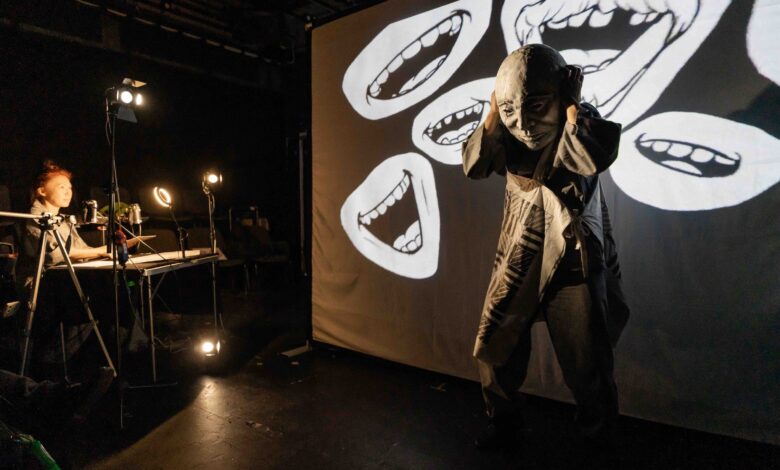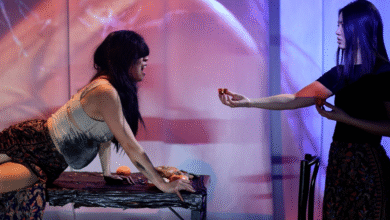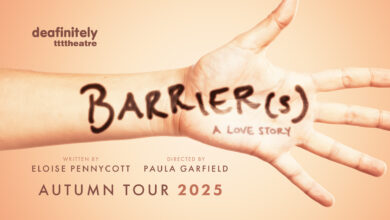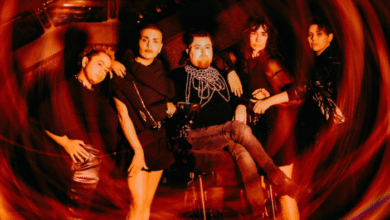Interview: Fusion paper puppetry and projection in progress

Aya Nakamura talks Akutagawa and creating ‘Live Manga’
Here at ET Towers we are always keen to keep our eyes open for new and exciting forms of theatrical creativity, so we were delighted to find out about Rouge28 Theatre’s current project Akutagawa. Described as ‘Live Manga’, it combines both Japanese and heritage art forms – Kamishibai and Toy Theatre – with live video projections. A preview of the work recently featured in the Bush Theatre’s Alt B: Twisted Roots Festival and will be showing again in Lewisham later this month. We caught up with Aya Nakamura, co-designer and performer, to learn more about this unique and innovative piece of work.
Aya, thanks so much for talking to us today about Akutagawa. You recently previewed your work at the Twisted Roots Festival. How did you become connected with the festival, and how was the piece received?
Thank you, Mary, for giving us the chance to talk about our project!
As part of their 30th anniversary, New Earth Theatre organised the Twisted Roots festival to celebrate British East and Southeast Asian arts heritage in the modern theatre landscape. We have been selected to be part of the festival, and have received seed funding through their incubators programme to develop our new project Akutagawa.
We have been partnered with Camden People’s Theatre, who offered us two weeks of rehearsal space. On 4 September we presented 20 minutes of our first stage development at the Bush Theatre.
It has been a wonderful opportunity, and we felt fortunate to have received support from New Earth Theatre, as well as from the Great Britain Sasakawa Foundation and Arts Council England. The premiere went really well – the audience responded enthusiastically to the form, with some saying they had never seen anything like it before. Of course, there is still much we would like to refine, but we were proud to present a strong piece that clearly expressed our intentions.
For those who don’t know, can you explain a little about what the elements of Kamishibai and Toy Theatre involve?
Kamishibai is a form of Japanese paper theatre that originated as a kind of street performance, where stories are told by revealing a sequence of illustrated panels. In our show, we use a large screen and a small desk set off-centre. I manipulate background panels and paper puppets placed on the desk, while two cameras capture the movement and project it live onto the big screen on stage. Alongside this, we have a masked actor who interacts with the projected paper characters, or who appears within the settings created by the paper backgrounds. So, it is like a gigantic digital Toy Theatre!
You describe the style as being ‘Live Manga’ – can you talk about that?
We wanted to explore how Manga could be directly translated onto the stage, not by staging an anime, but by capturing the distinctive visual language of Manga itself. I’ve always been fascinated by its unique ways of storytelling. At the same time, I wanted to embrace the rawness and simplicity of paper puppet movements, and to make the act of puppeteering visible as part of the performance.
What are the stories being told at the core of the production?
Our piece is inspired by several short stories by Ryunosuke Akutagawa, a celebrated modern Japanese writer who wrote a lot of short stories. Throughout the piece, our protagonist, Kandata, is reincarnated into different characters of different periods of Japanese history, only to discover in the end that he is the one shaping his own destiny.
For the current version, we have been focusing on one of Akutagawa’s stories called The Dragon. It is a funny and dark piece about Kandata, who is reincarnated as a monk, and is mocked by everyone around him. One day, he decides to play a prank to the whole town by pretending that a dragon will rise to the heavens from a very small pond. Unfortunately, this silly joke will take an unexpected turn.
Who else is working on the project with you and what skills do you each bring to the table?
Rouge28 Theatre consists of Paul Piris – a director and independent puppetry researcher – and myself, Aya Nakamura, a puppeteer and puppet maker. Together, we create stories that can best be told through puppetry. For this project, we collaborated with UK-based Japanese Manga artist Inko Takita, who illustrated all the images, and with Japanese actor Kimihiko Katamura, who brought Kandata vividly to life. There are a lot of more collaborators, but I will avoid giving you a full list!
Tell us about the next event in Downham Library and who should attend.
Our performance at Downham Library is part of the East and South East Asian Heritage month organised by Lewisham Borough. We will perform on Wednesday 24 September at 6pm. The performance will be free (but you need to reserve tickets online).
Everyone is welcome to come along. The performance will be particularly appealing to those with an interest in visual theatre, puppetry, or Japanese culture. From what we’ve seen so far, the show resonates strongly with teenagers, though it isn’t aimed at very young children.
What do you hope will be the ultimate goal for this project?
Our aim is to develop this project into a full-length production. We already know which of Akutagawa’s stories we want to use, and we’ve decided on the historical periods in which they will be set. Each tale takes place in a different era, and we want to bring that variety to life. The show is designed to be performed in theatre and non-theatre spaces such as libraries, galleries, or community centres.
What we need now is the time and resources to make it happen. Ideally, we would love to present Akutagawa in London and then to tour the piece nationally and internationally as we have done with our previous shows in the past.
Thanks very much to Aya for filling us in on this unusual and exciting work. The next preview of Akutagawa is at Downham Library on Wednesday 24 September.








One Comment